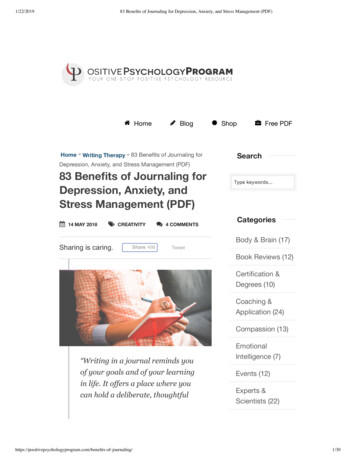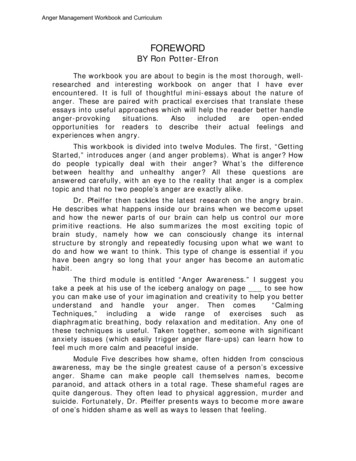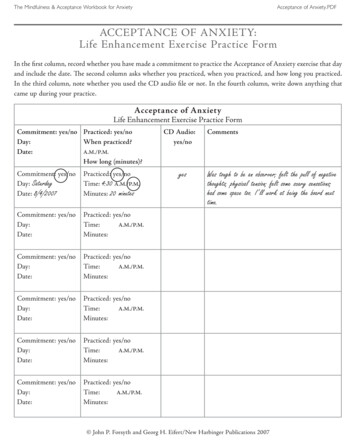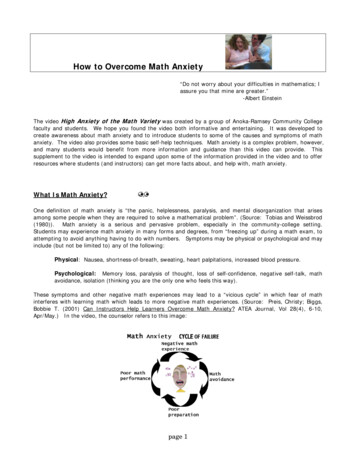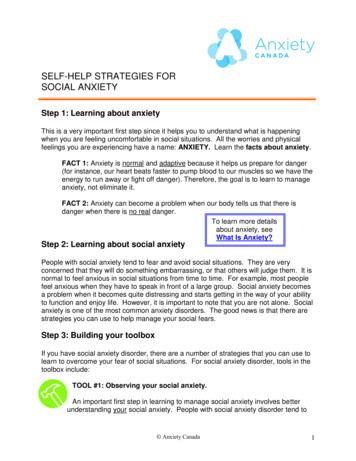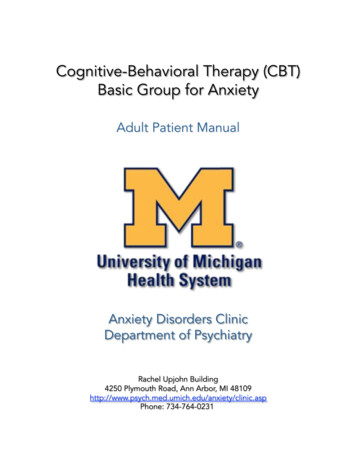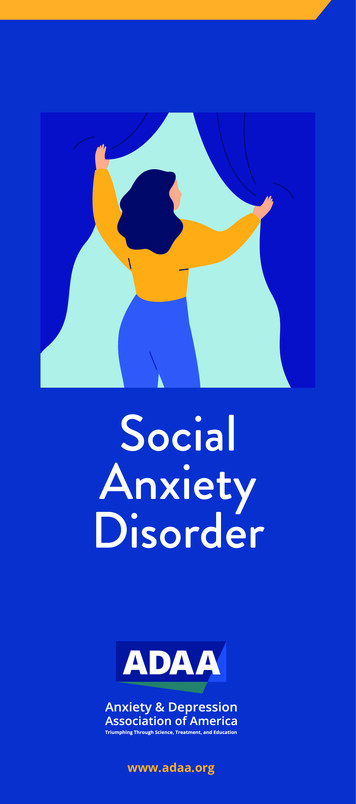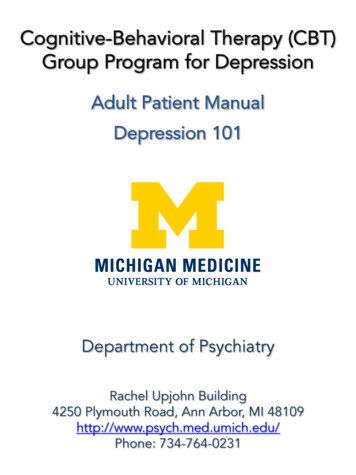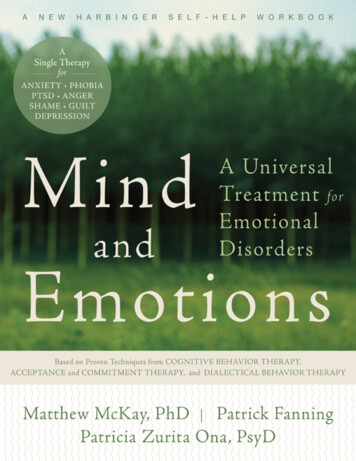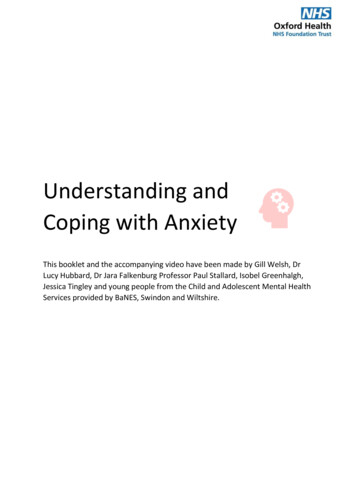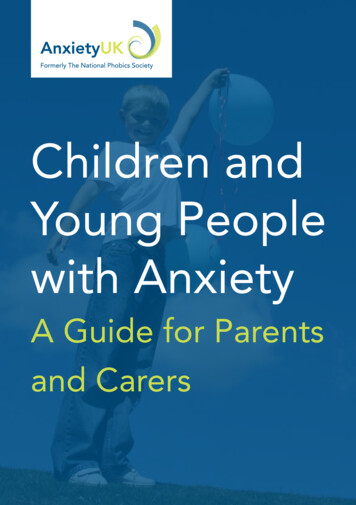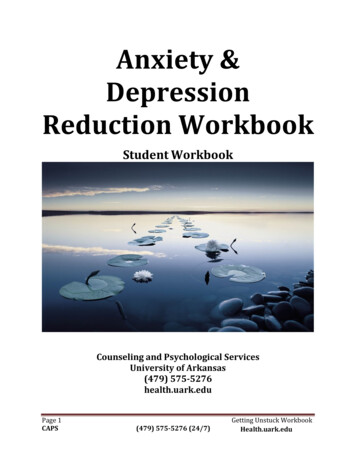
Transcription
Anxiety &DepressionReduction WorkbookStudent WorkbookCounseling and Psychological ServicesUniversity of Arkansas(479) 575-5276health.uark.eduPage 1CAPS(479) 575-5276 (24/7)Getting Unstuck WorkbookHealth.uark.edu
Table of ContentsWelcome & Frequently Asked QuestionsConfidentialityIn Session WorksheetsSession 1: Understanding Anxiety & DepressionSession 1: Square BreathingSession 1: Short Relaxation TechniquesSession 1: Understanding Depressive DisordersSession 1: Stress Versus AnxietySession 1: Understanding Anxiety DisordersSession 1: Stress Curve & Avoidance Roller CoasterSession 1: Threat System SymptomsSession 2: Self CareSession 2: Breath-Counting ExerciseSession 2: Sleep Hygiene & Exercise TipsSession 2: Core Values AssessmentSession 2: Self-Care WorksheetSession 2: Pleasant Activities ListSession 3: The Cognitive Behavioral ModelSession 3: Progressive Muscle Relaxation ScriptSession 3: Common Anxiety SymptomsSession 3: Common Depressive SymptomsSession 3: Example: Cross Sectional Formulation (Anxiety)Session 3: Example: Cross Sectional Formulation (Depression)Session 3: Cross Sectional Formulation (Blank)Session 3: Feelings WheelSession 3: Cross Sectional Formulation (Blank)Session 4: Automatic Thoughts and Unhelpful CognitionsSession 4: “54321” Grounding ExerciseSession 4: Unhelpful Thinking StylesSession 4: Unhelpful BehaviorsSession 4: Cross Sectional Formulation (Blank)Session 4: Maintaining Depressed Mood WorksheetSession 4: Maintaining an Anxious State WorksheetSession 5: Alternative ResponsesSession 5: Guided ImagerySession 5: Identifying Triggers WorksheetSession 5: Self-Affirmations WorksheetSession 5: Example: Alternative Response Worksheet (Anxiety)Session 5: Example: Alternative Response Worksheet (Depression)Session 5: Alternative Response Worksheet (Blank)Session 5: If you’re having trouble Alternative Thought QuestionsSession 5: If you’re having trouble Behavior & Feelings QuestionsSession 5: Other Helpful Thought TipsSession 5: My Plan for Managing Anxiety/DepressionAppendixOnline Resources Apps & booksHelpful Behavioral TipsBehavioral Tips for Managing DepressionGrounding ExercisesCross Sectional Formulation (Blank)Alternative Response Worksheet (Blank)Page 2CAPS(479) 575-5276 (24/7)Page 3Page 5Page 6Page 7Page 8Page 9Page 10Page 11Page 12Page 13Page 14Page 15Page 16Page 17Page 18Page 19Page 20Page 21Page 22Page 23Page 24Page 25Page 26Page 27Page 28Page 29Page 32Page 33Page 34Page 35Page 36Page 39Page 40Page 41Page 42Page 43Page 44Page 45Page 46Page 47Page 48Page 49Page 50Page 51Page 53Page 54Page 55Page 56Page 57Page 58Page 62Getting Unstuck WorkbookHealth.uark.edu
Welcome!Welcome to Anxiety and Depression Reduction Workshop, a workshop intendedto help increase your understanding and knowledge about anxiety and depression.The goal of this seminar is to provide you with life-long tools you can use whilefacing anxiety or depression triggering situations. The goal is to provide you withsome skills to recognize and manage symptoms you may be experiencing.Remember, this intervention is not intended to “get rid of” your anxiety/depression.Our hope is that these five sessions provide you with a jumping board from which tointegrate skills into your daily life in the service of reducing anxiety.By the end of this course, you will have received a lot of information and at times itmay feel overwhelming. Remember that like any skill (e.g., learning to ride a bike),the skills you will learn in Anxiety and depression Reduction Workshop taketime and practice to master. At times, you may encounter obstacles and/or find itdifficult to integrate these skills into your daily life. That’s okay, it’s how changeworks, and as with all change, it’s important to practice as much as you can, evenafter encountering setbacks.Think of your practice of these skills as a form of “mental health hygiene.” At theoutset, it may seem tedious and you may question why you need to practice theseskills so often. Think of it like dental hygiene—you brush your teeth multiple timesa day to prevent the buildup of plaque and ultimately to prevent cavities. Similar tobrushing your teeth, daily practice prevents a buildup of sadness and anxiety overtime and can minimize and prevent long-term symptoms. The more you practiceand use these skills as part of your daily routine, the less tedious they may seembecause they simply become a regular part of daily life.Should you wish to focus more in depth on any of your depression-related oranxiety-related concerns, you may debrief with a therapist following completion ofworkshop to discuss options.If at any time you feel that you need additional support, please let your leader knowor contact Counseling Services at (479) 575-5276. You may also find additionalresources online at health.uark.edu/mental-health/.Page 3CAPS(479) 575-5276 (24/7)Getting Unstuck WorkbookHealth.uark.edu
Frequently Asked Questions (FAQ)What if I have an urgent need to see a counselor during the workshop?Simply let the facilitator or Counseling Services’ front desk staff know and they willfacilitate you getting the help you need.What if I need more than 5 weeks to learn the model?You are not alone. The skills are difficult and take time to build. If you need moreresources, we encourage you to follow-up with the group facilitator.What if I don’t feel comfortable in groups?Many people feel a little anxious about participating in a group. This workshop isstructured and curriculum-driven, like a class. You are not required to speak ifyou do not feel comfortable doing so. The facilitators respect each participant’sright to share only what they are comfortable sharing and never require you toshare sensitive or potentially embarrassing information.Why do I have to do homework?The focus of this workshop is on building skills to cope with anxiety/depression; inorder to achieve that goal, regular practice is essential. The more you practice, themore you may find you get out of this workshop. The assignments are for you andonly you, in the service of your own personal growth. You will not be required toprovide your responses at any time during this workshop; however, it’s importantto bring your responses as you may be asked to look back on or elaborate on a priorassignment during the workshop.What if I didn’t do my homework?We encourage you to come to group regardless of whether or not you were able tocomplete the homework assignment. If you forget your workbook, we can provideyou a new one. We can also assist you in working on examples when the homeworkis reviewed.Page 4CAPS(479) 575-5276 (24/7)Getting Unstuck WorkbookHealth.uark.edu
Confidentiality Contract for Workshop/Group1. This instrument is a contract for confidentiality among the members of this groupand for the area of CAPS.2. Each member of the workshop/group acknowledges the need to keep personalinformation shared in the workshop/group private.3. For the purpose of this workshop/group, any information shared by aworkshop/group member should be considered personal and private information.4. In order to become a workshop/group member and maintain membership, eachperson must agree to protect this private information. Information gathered aboutother members of the workshop/group cannot be shared with anyone else. Thatinformation shall remain with the workshop/group members and not betransmitted or communicated to other people.5. Each member agrees to silence phones and not take any photographs or post insocial media about members of the workshop/group.6. Each member of the workshop/group agrees to keep confidential the identity of anyothers seen at CAPS in order to protect their confidentiality.7. If you agree to abide by these restrictions, please acknowledge your agreement bysigning in the space below.Name of Workshop/GroupStudent ID NumberSignature of group memberDatePrinted NameEmailAddress:Cell phone #City, State, ZipSignature of workshop/group facilitatorPage 5CAPSDate(479) 575-5276 (24/7)Getting Unstuck WorkbookHealth.uark.edu
IN SESSIONWORKSHEETSPage 6CAPS(479) 575-5276 (24/7)Getting Unstuck WorkbookHealth.uark.edu
SESSION 1:UnderstandingAnxiety/DepressionPage 7CAPS(479) 575-5276 (24/7)Getting Unstuck WorkbookHealth.uark.edu
Square Breathing1. Place one hand on our stomach and one on our chest. You want to feelthe hand on our stomach move in and out more than the hand on ourchest.2. Take a deep breath in through your nose. As you inhale you count inyour mind 1 2 3 4 and you imagine using the air you breathe in topush against your hand on your stomach.3. Hold for a count of 4. Then you exhale through your mouth like you areblowing out a candle.4. Exhale for a count of 1 2 3 45. Pause for a count of 4 before starting again.Helpful Practice Tips: Practice these techniques daily. Choose a consistent time each day that is free from distractions andcalm. (Before bed is a great time because it can also help with difficultiesfalling asleep) Practice these strategies in a calm environment and consistently inorder to increase your ability to access them when you arestressed/anxious. The more you practice these strategies the easier they will be to accesswhen you are anxious.Page 8CAPS(479) 575-5276 (24/7)Getting Unstuck WorkbookHealth.uark.edu
Short Relaxation Techniques: When you only have a few minutesCorrect BreathingLearn to always breathe using the diaphragm. Let the breath reachthe bottom of the lungs, and let the chest and shoulders relax.High, shallow chest breathing is stressful and gives messages ofstress to the brain.Three-PartBreathingTake a deep breath and imagine the lungs divided into three parts.Visualize the lowest part of the lungs filling with air; the chestshould remain relatively still. Imagine the middle part of the lungsfilling; visualize the rib cage expanding. Visualize the upper partfilling with air as your shoulders rise slight and over backward.Exhale fully and completely; drop your shoulders, feel your ribcage contract, and force every bit of air from the bottom of thelungs. Repeat.StretchingGently roll your head and shoulders many times a day. Also, gentlystretch other areas of the body that may need it.Tense-Relax Muscles Tighten the muscles you want to relax and feel the tension. Let themuscles become loose and limp and feel the relaxation.Body ScanWith your mind, briefly scan every muscle in your body from yourtoes to your head. Release any tension with a relaxing breath.Correct your posture and relax all the muscles you are not using.Jaw DropBe aware of any tightness in your jaw. Allow your jaw to loosen byseparating your teeth.Heaviness andWarmth in Hands &ArmsRelax your body and feel heaviness in your arms and hands.Imagine a warmth flowing through them. Imagine and experiencesyour shoulders, arms, and hands becoming heavy, relaxed, andwarm.Mind-QuietingMeditationBegin by focusing on your breathing. Use a special phrase thathelps you focus on relaxation, and quiet your mind.Attitudes &PerceptionsPay attention to your perceptions and attitudes. Allow yourself toput a stress-reducing “frame” around the stressor. Remember,stress affects the body based on your perceptions of the outsideworld.Page 9CAPS(479) 575-5276 (24/7)Getting Unstuck WorkbookHealth.uark.edu
Understanding Depressive and other Related DisordersWhile some depressive symptoms (i.e., sadness) are a normal experience foreveryone, depressive and other related disorders are characterized bysignificant distress or impairment in social, academic/occupational, or otherimportant areas of functioning (e.g., your general ability to function in life).Some of the most common disorders include:Major DepressiveDisorder:Involves experiencing depressive episodes, whichmust last for two weeks, and include a minimum of5 symptoms.Persistent Depressive A less extreme depressive presentation thatDisorder:includes a depressed mood and at least 2 othersymptoms that last for at least two years. May haveepisodes of major depression along with periods ofless severe symptoms, but symptoms must last fortwo years.PremenstrualDysphoric Disorder:Bipolar II Disorder:CyclothymicDisorder:Disruptive MoodDysregulationDisorder:Page 10CAPSSeveral depressive symptoms present consistentlyduring the week prior to menses.Includes experiences of both depressive episodesas well as "mixed" or hypomanic episodes (i.e.,elevated mood with other expansive symptoms).Persistent periods of alternating between "highs"and "lows" that are subthreshold for hypomanicand depressive episodes.Recurrent temper outbursts and persistentlyirritable or angry mood for at least one year(present between ages 6-18).(479) 575-5276 (24/7)Getting Unstuck WorkbookHealth.uark.edu
Stress versus AnxietyEveryday Anxiety (Stress)Anxiety DisorderIn response to a knownenvironmental factorIn response to an unknown source orin response to the experience ofstressSymptoms go away when thestressor goes awaySymptoms remain despite noidentifiable stressorWorry about living away fromhome for the first time, passing aclass, a romantic breakup, or otherimportant life eventsConstant and unsubstantiated worrythat causes significant distress andinterferes with your daily lifeEmbarrassment or selfAvoidance of social situations due toconsciousness in an uncomfortable fear of being judged, embarrassed, oror awkward social situation; feeling humiliatednervous about meeting new peopleFeeling nervous or sweating beforea big test, class presentation, stageperformance, or other significanteventPanic attacks that seem out of theblue and preoccupation with the fearof having another oneRealistic fear of a dangerous object,place, or situation (e.g. fear ofpoisonous snakes)Irrational fear or avoidance of anobject, place, or situation that poseslittle or no threat of danger (e.g. fearof elevators)Making sure that you are healthyand living in a safe environmentPerforming uncontrollable repetitiveactions, such as excessive cleaning,checking, touching or arrangingAdapted from: http://www.adaa.org/understanding-anxietyPage 11CAPS(479) 575-5276 (24/7)Getting Unstuck WorkbookHealth.uark.edu
Understanding Anxiety DisordersWhile anxiety is a normal and adaptive experience for everyone, anxietydisorders are characterized by significant distress or impairment in social,academic/occupational, or other important areas of functioning (e.g., yourgeneral ability to function in life).Some of the most common anxiety disorders include:Generalized Anxiety Disorder:Chronic and unrealistic worry that feelsdifficult to control about everyday things(i.e., things that do not worry most people)Social Anxiety Disorder:Chronic worry solely related to socialsituationsPanic Disorder:Characterized by episodes of “panic” thatinclude things like: adrenaline surge, fear oflosing control, chest pain, racing heart,shortness of breath, dizzinessPhobias:Specific fears that are excessive in natureand often lead to avoiding that which isfeared (e.g., public speaking, heights, tunnels,etc.)Obsessive-Compulsive Disorder: Excessive rumination (thinking) withrepetitive behaviors to reduce anxietyPage 12CAPS(479) 575-5276 (24/7)Getting Unstuck WorkbookHealth.uark.edu
Anxiety - Avoidance Roller CoasterAdapted from- anxietyPage 13CAPS(479) 575-5276 (24/7)Getting Unstuck WorkbookHealth.uark.edu
Threat System (Fight or Flight)The ‘fight or flight’ response gets the body ready to fight or run away. Once a threatis detected your body responds automatically. All of the changes happen for goodreasons, but may be experienced as uncomfortable when they happen in ‘safe’ situations.Thoughts racinghelps us to evaluatethreat quickly and makerapid decisions, can be hardto focus on anything butthe feeling of dangerDizzy or lightheadedChanges to visiontunnel vision, or visionbecoming ‘sharper’Breathing becomesquicker andshallowerDry mouthto take in more oxygenand make our body moreable to fight or run awayHeart beats fasterfeeds more blood tothe muscles andenhances ability tofight or run awayAdrenal glandsrelease adrenalineadrenaline signals otherorgans to get readyBladder urgencymuscles in the bladder relaxin response to stressHands get coldPalms becomesweatyblood vessels in the skincontract to force bloodtowards major musclegroupsthe body sweats to keep cool, thismakes it a more efficient machineMuscles tenseready to fight or run awaythey may also shake ortremblePSYCHOLOGYTPage 14CAPSLShttp://psychology.tools(479) 575-5276 (24/7)Getting Unstuck WorkbookHealth.uark.edu
SESSION 2:Self-CarePage 15CAPS(479) 575-5276 (24/7)Getting Unstuck WorkbookHealth.uark.edu
Breath-Counting ExerciseThis exercise focuses on the use of counting with the rhythm of the breath.Start with a short period of time and gradually increase the time. Set a timerso that you do not have to worry about when to stop.1. Find a comfortable position. Take several deep breaths and settle intoyourself. You may either close your eyes or keep them open, depending onyour own comfort. If you keep them open, fix them on an object or a spoton the floor about four feet in front of you. Your eyes may be either focusedor unfocused.2. Take deep, comfortable breaths. Notice your inhalation. The pausebetween inhaling and exhaling, your exhalation, and the pause beforestarting again.3. As you inhale, count, “one.” As you exhale, count, “two.” Inhale, “three.”Exhale, “four.” Continue until you reach 10 then start over.4. If you lose count, simply begin with “one” on your next inhalation.5. If you notice your mind has wandered, gently notice this, and return yourfocus back to counting your breathPage 16CAPS(479) 575-5276 (24/7)Getting Unstuck WorkbookHealth.uark.edu
Sleep Hygiene 1. Get regular. Go to bed and get up at more or less thesame time every day, even on weekends and days off!2. Get up and try again. Try to go to sleep only whentired. If you haven’t been able to get to sleep afterabout 30 minutes, get up and do something calming(not stimulating) until you feel sleepy, then return tobed and try again.3. Avoid caffeine and nicotine.Avoid consuming any caffeine(coffee, tea, soda, chocolate) ornicotine (cigarettes) for at least4-6 hours before going to bed.These act as stimulants and interfere with fallingasleep.4. Avoid alcohol. Avoid alcohol for at least 4-6 hoursbefore bed because it interrupts the quality of sleep.5. Bed is for sleeping. Try not to use your bed foranything other than sleeping and sex, so that yourbody comes to associate bed with sleep.6. Electronics curfew. Don’t use back-lit electronics 60minutes prior to bed, as the artificial light inhibitshormones and neurons that promote sleep.7. No naps. Avoid taking naps during the day. If youcan’t make it through the day without a nap, makesure it is for less than an hour and before 3pm.8. Sleep rituals. Develop rituals toremind your body that it is timeto sleep, like relaxing stretchesor breathing exercises for 15minutes before bed.9. No clock-watching. Checking the clock during thenight can wake you up and reinforces negativethoughts such as, “Oh no, look how late it is, I’ll neverget to sleep.”10. The right space. Make your bed and bedroom quietand comfortable for sleeping. An eye mask andearplugs may help block out light and noise.11. Keep daytime routine the same. Even if you have abad night’s sleep, it is important that you try to keepyour daytime activities the same as you had planned.That is, don’t avoid activities because you feel tired.This can reinforce the insomnia.Exercise Tips 1. Find an enjoyable activity. Exercise doesn’t haveto be boring. Choose a pleasurable activity, likeplaying badminton or doing yoga. Aim for fun, notmore work.2. Start small. Commit to 10 minutes of exercise a dayor add exercise to your daily routine (like walkingto school or doing push-ups in your room).3. Get outside. The sun provides amood “pick me up” of its own,producing serotonin in the brain.Take a walk outside or goswimming.4. Schedule it in. It’s easy to skipexercise when we don’t plan. Put it in your phone aspart of your daily to-do’s and celebrate when youcheck it off.5. Mix it up. To avoid feeling bored with exercise, trya number of different activities.Page 17CAPS6. Team up. Depression can be isolating. Ask others todo team activities or find an exercise buddy foraccountability and to increase social interaction.7. Minimize equipment.Equipment can be expensive.Identify activities that don’trequire you to have equipment orfacilities, like walking, running, ordancing.8. Follow your energy. If your energy fluctuatesthroughout the day, try to plan to exercise whenyour energy is at its peak. Alternatively, exercisewhen feeling sluggish for an energy boost.9. Set goals. Achieving goals improves mood and selfesteem. Set specific achievable exercise goals andreward yourself when you accomplish them.(479) 575-5276 (24/7)Getting Unstuck WorkbookHealth.uark.edu
Page 18CAPS(479) 575-5276 (24/7)Anxiety Toolbox WorkbookHealth.uark.edu
SELF-CARE WORKSHEETRate current use of wellness practices in your everyday life 0 (non-existent) to 5 (use every day).Wellness practices can include, pleasant activities, yoga, meditation, journaling, etc.)What are your current roadblocks to effective self-care?What self-care/wellness practice would you like to implement? What values underline thisgoal? (see list)TIPS TO IMPLEMENTING EFFECTIVE SELF-CARE: Choose what wellness practice you are going to implement (see the list below if you do nothave activity you would like to implement) Create a schedule when you are going to implement the activity Stick to the same schedule everyday Identify how you will overcome a roadblock if it presents itselfWhat is your plan to implement effective self-care?The smallest, easiest step I can begin with is:The time, day, and date that I will take the first step is:Page 19CAPS(479) 575-5276 (24/7)Anxiety Toolbox WorkbookHealth.uark.edu
Pleasant ActivitiesActingAttending aconcertBeingcounseledBeachcombingBeing aloneBeing complimentedAmusingpeopleBeing coachedBeing in thecountryBeing at a familyget-togetherBeing with happypeopleBeing in themountainsBeing with myroommateBeing withsomeone I loveBeing told I amlovedBoating/ canoeingBudgeting mytimeBuying thingsfor myselfCampingCaring forplantsCanning/ MakingpreservesCheering forsomethingCollectingthingsCounseling someoneDatingsomeone I likeComplimentingor praisingsomeoneDoing art workCookingDancingCombing/brushing myhairDesigning/DraftingBuyingsomething forsomeone I careaboutCompleting adifficult taskDoingexperimentsDoing favors forpeople I likeDoing houseworkDreaming atnightDriving longdistancesEating goodmealsExploring/HikingExpressinglove tosomeoneFeeling the presenceof a Higher PowerFishingFixingmachinesGatheringnatural objectsGiving giftsGiving a partyfor someoneGetting up earlyGetting massagesGivingmassagesGoing tolecturesGoing to a luncheon/potluckGoing to themoviesGoing to a playGoing to arestaurantGoing to a reunionGoing to a spiritual/peaceful placeGoing to asports eventGoing to abarber/beauticianGoing on naturewalks/ fieldtripsHavingdaydreamsGoing to aconcertGoing to a health club/sauna/spaGardening/DoingyardworkGoing to anamusementpark/ zooGoing to amuseumHaving friendsover to visitHaving alively talkHaving lunch withfriendsKicking sand/pebbles/leavesLooking at the stars/moonKissingPlaying with apetPlaying innaturePlaying a boardgame/ chessListening tothe ratioPlanning ororganizingsomethingPhotographyListening to musicMaking a newfriendLearningsomething newMeditating/Doing yogaSeeingbeautifulscenerySeeing goodthings happento peopleSeeing old friendsWatching TVWriting in a journalHavingcoffee/tea withfriendsKnitting/crochetingMaking food togive awayDiscussing myfavorite hobbyLaughingPlaying cardsMakingcharitabledonationsPlaying musicReadingReminiscingRiding in anairplaneRunning/joggingSaying prayersSewingShavingSingingSleeping lateSmelling a floweror plantSpeaking a foreignlanguageStaying up lateSmiling atpeopleTaking a bathUsing mystrengthsPage 20CAPS(479) 575-5276 (24/7)Being withanimalsBeing at afraternity/sororityBeing withmy parentsBeing at the beachBeing with friendsBird-watchingPlaying sportsRepairing thingsSolving a puzzle/crosswordAnxiety Toolbox WorkbookHealth.uark.edu
SESSION 3: The CognitiveBehavioral ModelPage 21CAPS(479) 575-5276 (24/7)Anxiety Toolbox WorkbookHealth.uark.edu
Progressive Muscle Relaxation Script Sit back or, when you are at home, lie down in a comfortable position. Shut your eyes if you’re comfortable doingso; if not, soften your gaze on a fixed point.Start by taking a deep breath and noticing the feeling of air filling your lungs. Hold your breath for a few seconds.One .two .three. Release the breath slowly and let the tension leave your body.Now, take another deep breath and hold it. One .two .three . Slowly release the air.Even slower now, take another breath in. Fill your lungs and hold the breath. One .two .three. Slowly releasethe breath and imagine the feeling of tension leaving your body with each breath out.We are going to begin progressively tensing and releasing our muscles. Let’s start by clenching our fists, tighterand tighter. Hold. Study the tension in your fists, wrists and forearms as you hold the clenched fist. (5 secondpause). Now let go and relax your hands. Feel the looseness in your hands and notice the contrast between thetension and the feeling of relaxation. (5 second pause)Now bend your elbows and tense your biceps. Tense them as hard as you can and observe the feeling oftautness. Hold. (5 second pause). Okay, relax. Straighten out your arms. Notice the feeling of relaxation in yourhands, arms, and shoulders. Notice how your arms feel limp and at ease. (5 second pause)Okay, let’s turn our attention to our head. Wrinkle your forehead as tight as you can. Hold. (5 second pause) Nowrelax and smooth it out. (5 second pause)Now close your eyes, squint them tighter. Feel the tension. (5 second pause). Now, relax your eyes. Let themremain closed gently and comfortably. (5 second pause)Okay, still focusing on our heads, roll your head to the right and feel the changing locus of stress, roll it to the left.(5 second pause)Straighten your head and bring it forward. Press your chin against your chest. Feel the tension in your throat,the back of your neck. Hold. (5 second pause) Relax, allowing your head to return to ta comfortable position. Letthe relaxation deepen. (5 second pause)Next, tense the muscles in your back by bringing your shoulders together behind you. Hold them tightly. Tensethem as hard as you can without straining and keep holding (5 second pause). Now let go. Release the tensionfrom your back. Feel the tension slowly leaving your body, and the new feeling of relaxation. Notice howdifferent your body feels when you allow it to relax. (5 second pause)Now shrug your shoulders up to your ears and hold. (5 second pause) Relax your shoulders. Drop them back andfeel the relaxation spreading through your neck, throat and shoulders. Give your body a chance to relax. Feel thecomfort and the heaviness. (5 second pause)Next, breathe in and fill your lungs completely. Hold your breath. Notice the tension. (5 second pause) Nowexhale. Let the air hiss out and let your chest become loose. Continue relaxing, letting your breath come freelyand gently. (5 second pause)Now tighten your buttocks and thighs. Squeeze your thighs as hard as you can and hold. (5 second pause).Release. Feel the difference as you let go. (5 second pause)Now let’s move our attention to the calves and feet. Press your toes downward, making your calves tense. Studythe tension. (5 second pause). Relax. (5 second pause).Now bend your toes towards your face, creating tension in your shins. (5 second pause). Relax again. (5 secondpause).Okay. Finally, tense your entire body. Tense your feet, legs, stomach, chest, arms, head, and neck. Tense hard,without straining. Hold the tension. (5 second pause). Relax. Feel the looseness and heaviness throughout yourbody as the relaxation deepens. Let go more and more. Experience the relaxation deepening. Pay attention to thefeeling of relaxation, and how different it is from the feeling of tension (Wait 10 seconds).Begin to wake your body up by slowly moving your muscles. Adjust your arms and legs. Stretch your musclesand open your eyes when you’re ready.Page 22CAPS(479) 575-5276 (24/7)Anxiety Toolbox WorkbookHealth.uark.edu
Common Anxiety SymptomsPhysical Symptomso Increased heart rateo Shortness of breatho Chest pain or pressureo Choking sensationo Dizziness, lightheadednesso Sweating, hot flashes, chillso Nausea, upset stomach,diarrheao Trembling, shakingo Weakness, unsteadiness,faintnesso Tense muscles, rigidityo Dry moutho Other:Behavioral Symptomso Avoidance of threat cues orsituationso Escape, flighto Pursuit of safety, reassuranceo Restlessness, agitation,pacingo Hyperventilationo Freezing, motionlessnesso Difficulty speakingo Other:Page 23CAPSCognitive Symptomso Fear of losing control, beingunable to copeo Fear of physical injury ordeatho Fear of “going crazy”o Fear of negative evaluationsby otherso Frightening thoughts, images,or memorieso Perceptions of unreality ordetachmento Poor concentration,confusion, distractibilityo Narrowing of attention,hypervigilance for threato Poor memoryo Difficulty in reasoning, loss ofobjectivityo Other:Emotional Symptomso Feeling nervous, tense,wound upo Feeling frightened, fearful,terrifiedo Being edgy, jumpy, jitteryo Being impatient, frustratedo Other:(479) 575-5276 (24/7)Anxiety Toolbox WorkbookHealth.uark.edu
Common Depressive sFatigue or lowenergyIncreased orreduced sleepReduced focus/concentrationLow Mood orpersistentsadnessWithdrawingfrom friends,family, petsSuicidal thoug
Page 3 CAPS Getting Unstuck Workbook (479) 575-5276 (24/7) Health.uark.edu Welcome! Welcome to Anxiety and Depression Reduction Workshop, a workshop intended to help increase your understanding and knowledge about
